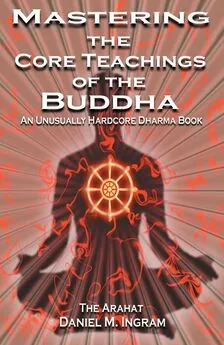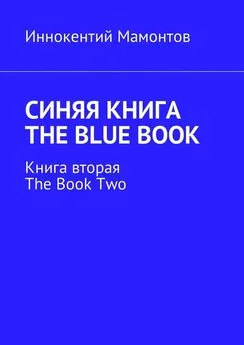Daniel Ingram - Mastering the Core Teachings of Buddha - An Unusually Hardcore Dharma Book
- Название:Mastering the Core Teachings of Buddha - An Unusually Hardcore Dharma Book
- Автор:
- Жанр:
- Издательство:Aeon Books
- Год:2009
- ISBN:9781904658405
- Рейтинг:
- Избранное:Добавить в избранное
-
Отзывы:
-
Ваша оценка:
Daniel Ingram - Mastering the Core Teachings of Buddha - An Unusually Hardcore Dharma Book краткое содержание
Mastering the Core Teachings of Buddha - An Unusually Hardcore Dharma Book - читать онлайн бесплатно полную версию (весь текст целиком)
Интервал:
Закладка:
A Clear Goal
ultimate truth you want on the spiritual path is to be found in the sensations of the wanting itself.
Thus, don’t look out there except to find wise guidance about how to look inward, for what you are looking for is “nearer than near.” It is in the looking. It is in the motivation. It is in the suffering, which is why this was the First Noble Truth that the Buddha taught. He went right for the heart of the thing. It is in the question itself, which is why koan training can work. The experience of the question contains the answer to the content of the question. It is in the undying love that drives our every wish for happiness.
Strangely, the process of creating the illusory sense of a self arises out of compassion, but confused compassion, which is desire. This may sound odd, but it is as if there was an eddy in reality that befuddled empty and compassionate awareness, which is not a thing nor separate from things. Thus, somehow it seems that there is something to defend, some separate self that must be protected. Thus, out of confused compassion, barriers and defense mechanisms continue to be erected to defend this territory, this illusion of a separate self. Spiritual practices are designed to systematically debunk this illusion and penetrate these barriers by providing clarity, whereas all of the traditions can easily become part of these barriers, cultures to defend, knowledge to assume is self or owned by self, and that sort of thing.
It is as if reality got caught in an unfortunate loop, and this is what we have to work with, as this loop of illusory duality thinks it is us. The natural tendency, given “our” lack of clarity, is to continue to defend this
“self” out of compassion and a lack of understanding that there never was such a thing. This defense and identification is the process of ego.
Interestingly enough, all of the phenomena that make up this process, i.e. all of the “defilements,” are themselves empty, intrinsically luminous and non-dual, though they seem otherwise by their own contrivance.
Teachings such as “you are already enlightened, but you have yet to realize it” point to this (see Moon in a Dewdrop, The Writings of Zen Master Dogen, edited by Kazuaki Tanahashi, for a particularly profound discussion of the uses of this dangerous point of view). Thus, realization is not something created but instead is discovered as being an intrinsic aspect of phenomena.
112
A Clear Goal
Thus, with enough stability and clarity (concentration and wisdom), this natural, compassionate process of manifestation can begin to function more skillfully, as it has better information to go on, and can begin to see that creating the illusion of a separate, permanent self was not at all helpful (though it seemed to be). At this point, “it” will then let go of the illusion it has been perpetuating and return to understanding its natural state, which is freedom and non-duality.
This is something that absolutely cannot be accomplished by an act of will. It only arises when the level of clarity is high enough and the heart accepting enough of things as they are. One might say that Grace favors the well-trained mind. The pronounced tenaciousness of this process of defending an illusory and arbitrary “self” demonstrates clearly just how much compassion and how much confusion there is in this. Work to see clearly so that the knot may begin to untie itself.
I include all of this in the section called “A Clear Goal” because the very sense of a drive to find something is actually the thing it is seeking.
The motivation is looking for itself. In those sensations themselves is something very powerful and amazing. However, in order to see this, a shift has to happen in which the drive becomes driven to understand the sensations of that drive itself rather than looking to future sensations for satisfaction. This is a completely unintuitive thing to do, and this is one reason why meditation practices can seem so awkward sometimes.
However, the fact that the drive or the goal contains its own solution is the reason why there is such relentless emphasis on being present to what is happening now. If we can get this drive to just chill on its future fixation and simply understand itself, insight is close at hand.
If you feel frustrated that your practice has not been as energized or as clear as you wish it to be, first sit with the fullness of that wish, with the fullness of that frustration, with the fullness of your fears, with the fullness of your hopes, with the fullness of that suffering and compassion, as clearly and bravely as you possibly can until you understand them to their very depths as they actually are. Channel all of this energy into clear, precise, kind and focused living and practice.
Since this whole book is clearly goal-oriented, I thought that it would be appropriate to add a few guidelines about formulating specific goals and working towards mastery that can help reduce the problems that 113
A Clear Goal
poorly conceived goals can cause. Goals tend to involve a heavy future component. The trick is to add a component that relates to the Here and Now as well.
For instance, one could wish to become enlightened. This is a purely future-oriented goal. One could also wish to understand the true nature of the sensations that make up one’s world so clearly that one becomes enlightened. This adds a present component and thus makes the whole thing much more reasonable and workable. One could simply wish to deeply understand the true nature of the sensations that make up one’s world as they arise in that practice session or during that day. This is a very immediate and present-oriented goal, and a very fine one indeed. It is also method-oriented rather than result-oriented. This is the mark of a good goal.
Similarly, one could try to be kind, honest or generous that day, try to appreciate interdependence that day, or try to stay really concentrated on some object for that practice session. These present and method-oriented goals are the foundation upon which great practice is based.
Purely future-oriented goals are at best mostly worthless and at worst very dangerous.
Wishing to become enlightened or more enlightened is only helpful if it helps one live in the present as it is. The same goes for training in morality and concentration, as articulated in Part I. A good friend of mine once forgot these basic rules of goal-oriented practice and strived with great energy for months to attain a goal that had nothing to do with the reality that he was experiencing at that time. The results were disastrous and the dark consequences of his error ring on to this day.
Don’t get burned by the shadow side of goal-oriented practice. Avoid competition and comparing your practice to others. Stay present-oriented whenever possible, and always avoid purely future-oriented or results-oriented goals! Also, be careful what you ask for. You just might get it but with a price you could never have imagined.
It should be noted that thoughts of the past and future occur now.
These sensations are worthy of investigation. “Future mind” is only a problem if the sensations that make it up are not understood as they are. A fun practice to try is consciously thinking thoughts whose content is past- or future-oriented and noticing that they occur now. There is 114
A Clear Goal
something particularly profound about this that might be missed on first inspection.
While I am on the subject of goal-oriented practice, I should say a few words about how to avoid overdoing it. First, if those around you, particularly those with a lot of experience in meditation and the spiritual life, are telling you that you should chill out a bit, they are probably saying it for good reason. Ask them why they think that and take their opinions into consideration. Now, it is true that sometimes people will tell you to chill out on your practice a bit just because of their own envy of your determination and diligence, but I haven’t found this to be a common occurrence.
When on intensive retreats, there are a few basic ways to sail a bit too far out there too fast. The first is to stop eating. It is true that there is a long and glorious tradition of people fasting when doing spiritual practice, but generally they do so because they want to bring on severely altered states of consciousness. Fasting when meditating is an effective technique for doing this. Should you be doing insight practices, altered states are not your intended focus, and so these are more likely to be distracting than helpful. Further, severely altered states of consciousness can sometimes be very disruptive and hard to process, leading to what might be considered by some to be temporary insanity. If you are the sort of person who would drop LSD when out in public, then the altered states that fasting might bring on would probably not be a problem for you. On the other hand, if you are on retreat with other people, consideration for the fact that they may not want to deal with the potential side effects of your vision-quest is warranted.
Another way to go way out on the edge is to stop sleeping. Sleep deprivation can eventually lead to very altered states of consciousness and visionary experiences. The exact same considerations that come into play with not eating apply. While it may be true that when doing intensive practice the need for sleep may go down to perhaps 4-6 hours or sometimes less, try to get at least some sleep every night.
There are those that are such macho meditators that they will try to sit for very long periods of time, say 10 to 24 hours. While this might seem like a really brave thing to do, a real tribute to one’s determination, I don’t see the point. I have managed to make very rapid 115
A Clear Goal
progress when on intensive retreats where the longest sit I did was 4
hours and most were less than 1.5 hours. However, if one sits long enough and really pushes the investigation with heroic effort, one can get into states of consciousness that are quite volatile. It can be very difficult to ground back down and integrate what comes out of that sort of extreme practice. Again, out of consideration for your mind and body, as well as for those around you on retreat who may not want to deal with your potential inability to integrate and control the energy that can be generated from that sort of practice, consider moderation in sitting.
Lastly, there are some who will try to mix mind-altering substances and meditation. This can seem like an easy and fast path. In fact, there are countless traditions that use these as an integral part of their path.
However, there are numerous strong warnings against doing this at all or against doing this without the guidance of those that really know what they are doing and when not in the proper setting (e.g. far out in the desert with no one around except a friend to keep you safe and no big cliffs or weapons nearby). I have found that simply doing really consistent insight or concentration practices well can quickly produce altered states and strange experiences that have taken me to the very brink of what I could handle skillfully and sometimes beyond, many of which I will discuss in Part III, so I don’t see the need for using mind altering substances. Further, there are reasons to learn to see things from different points of view on our own power so that these things may become a part of who and what we are rather than some transient side effect brought on by tinkering with our neurochemistry.
In short, those on the path of heroic effort can easily get side tracked into ritualistic displays that seem like heroic effort, but they are not. Heroic effort on the insight path means heroic investigation of the Three Characteristics of the sensations that make up our experience, whatever they may be. Thus, my advice when on an insight meditation retreat is to really power the investigation all day long, whether you are sitting, walking, reclining, standing, eating, washing, etc. Get enough sleep. Eat well to keep up your health. Take care of your body, particularly your knees and back.
Читать дальшеИнтервал:
Закладка:





![Дженнифер Гюнтер - The vagina book. Главная книга для тех, у кого есть этот орган [litres]](/books/1061538/dzhennifer-gyunter-the-vagina-book-glavnaya-kniga-dl.webp)




